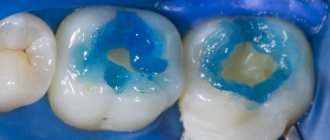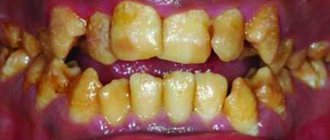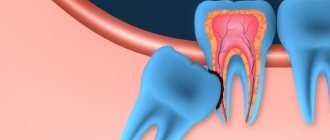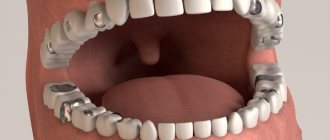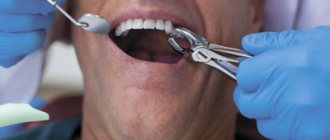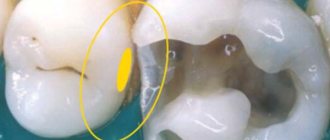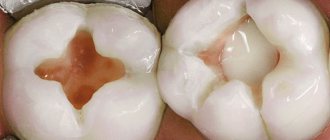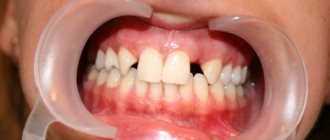3409
Dental implantation is a complex and time-consuming procedure that requires the dentist to have certain knowledge and skills, and consists of a large number of stages.
One of the intermediate procedures at the stage of restoring the integrity of the jaw row is taking impressions from the implants.
This is done with the help of special devices - impression transfers, which are fixed on the implant or abutment.
Concept and purpose
An impression transfer check is a part used in implantology to transfer the correspondence of the location of the implant fixed in the patient’s oral cavity to a working model.
It consists of two elements - a bushing, truncated cone-shaped with a cylindrical neck, and a mounting screw.
The material used to manufacture the device can be medical stainless steel or hypoallergenic titanium alloys.
Use during impression taking allows you to most accurately display the location of the implant or abutment in the jaw row , its inclination, and the position of the internal hexagon, if any.
This reduces the risk of making errors during the manufacturing and fixation of the selected prosthetic structure.
Taking impressions
During the implantation process, taking an impression of the jaw row plays a very important role. Obtaining a reverse image of the oral tissues in the area of the prosthetic bed allows you to create an exact copy of the patient’s jaw, which displays the location and placement features of the implants and the patient’s own teeth.
Based on the impression obtained in this way, a working model is made in a dental laboratory, which serves as the basis for the further design of a prosthesis or the manufacture of a specific orthopedic structure.
There are currently two methods of taking an implant impression:
- Imprint from the head of the product. The technology is most often used in cases where the decision on the shape and size of the abutment has not yet been made, as well as in the manufacture of a prosthetic structure fixed directly to the implant.
- Impression at the abutment level – used in case of preliminary selection and fixation of the abutment.
In addition, dentists note that in both of these cases, there are two options for taking an impression - open and closed impression tray .
The accuracy of the final result in both cases is the same, however, there are some features that require the choice of a specific type of procedure.
Features of zirconium abutments and advantages of individual products.
Visit here to learn more about the All on 6 implant method.
At this address https://www.vash-dentist.ru/implantatsiya/metodiki/kostnyih-materialov-v-stomatologii.html we’ll talk about the importance of bone material in dentistry.
Taking impressions
After the transfers are selected and screwed to the implants, a rigid or custom tray with impression material is brought into the oral cavity.
The mass hardens and the spoon is removed so that the transfers remain on the impressions. Then, in order to be able to recreate an exact copy of the location and inclination of the implants, implant simulators are attached to the transfers, and at the next stage, abutments appear on the working model, which are individualized to the structural features of the patient’s dental system and only now begin to manufacture crowns or other orthopedic structures.
As you can see, the process of prosthetics on implants requires much more effort, knowledge, practical skills and time, which naturally affects the final cost of denture structures.
To the list of posts
Material selection
The accuracy of making an impression of the jaw row for further implantation depends on various factors, the key of which is the quality of the impression material.
There are many requirements for the impression material, including:
- biocompatibility with oral tissues;
- high level of elasticity and viscosity;
- tensile strength;
- high resistance;
- sterility and non-toxicity;
- permissible degree of wettability and speed of solidification.
Based on these characteristics, experts most often give preference to silicone masses and polyesters.
In addition to the impression material, great importance is attached to the selection of a suitable transfer. Here the specialist pays attention to three factors:
- Transfer diameter. This parameter must correspond to the diameter of the gum former installed in the patient’s mouth.
When forming the level and relief of gum tissue using a temporary artificial crown, actions aimed at individualizing the standard impression device may be required. - Product height. To ensure that the subsequently manufactured prosthesis does not protrude above the remaining elements of the jaw row, the height of the device must correspond to the height of the teeth located adjacent to the missing one.
- Screw length. The optimal excess of the impression coping above the occlusal plane is 5-6 mm, based on this, the height of the screw should be selected.
General points for installing a crown on an implant, regardless of the method of fixation
When using both screw and cement fastening technologies, impressions are first created on the impression mass using transfers. The installation of a crown is done in different ways, but after fixing the prosthesis on the implant, the dentist always checks the contact points between the teeth with a special matrix. Then he controls the closure of the teeth so that the chewing load is subsequently distributed adequately.
The bite should be correct, uniform and dense. If there are errors, the service life of structures may be reduced. Therefore, if necessary, correction is carried out. A correctly installed denture has maximum contact with the base and has optimal gaps with the gum and adjacent teeth.
Impression of the implant
Before starting to take an impression of the jaw row during implantation, the dentist carries out a number of preparatory procedures:
- when the gingival tissue former is installed, the specialist removes it;
- An impression transfer is fixed to the head of the implant, selected taking into account the technique of the upcoming restoration, as well as the diameter of the gum former and abutment;
- an x-ray is taken to determine the correctness and accuracy of the device’s fit;
- The impression tray is tried on.
Further technology for taking an impression differs somewhat depending on which tray is used - open or closed.
Open spoon
The key feature of the open tray method of taking an impression is that the transfer check is tightly fixed in the impression material, so removing it from the jaw row requires turning out the fixing screw.
At the same time, this impression-taking technique allows not only to record the exact location of the implants, but also to obtain a clear image of the soft tissue relief in the area of the prosthetic bed.
The technology for taking impressions from implants using an open tray is as follows:
- The impression tray is tried on in the patient's mouth. It can be standard or custom made for the patient.
Most often, the product is made of transparent polymer material. This allows you to see the location of the screw and accurately mark the area for cutting holes. - Using a milling cutter or other suitable tool, a hole is cut in the spoon for the unhindered passage of the screw.
- Further steps to take the impression depend on the type of material used. So, when using a mass based on polyvinylsiloxane, it is applied around the devices, after which a spoon filled with the same material is placed in the oral cavity.
The use of monophasic impression material requires its introduction into the area of fixed structures using a syringe, as well as filling the impression tray with liquid mass and its placement in the jaw row.To prevent impression material from leaking through the drilled holes, specialists cover them with base wax.
- After the impression mass has finished hardening, specialists unscrew and remove the screws from the jaw line , after which they carefully remove the tray from the patient’s mouth. The transfers remain firmly fixed in the frozen impression mass.
- or temporary crown, which was removed before the procedure, onto the implant
After taking an impression in the laboratory, an analogue of the implant used is connected to the transfer check using a suitable screw, and an imitation of soft tissue is created around it.
After a thorough check of the position of all components of the structure, a working model is cast according to a standard protocol, on the basis of which the prosthetic structure will be subsequently manufactured.
The video shows the protocol for taking an impression with an open tray transfer.
Closed spoon
A distinctive feature of taking an impression using a closed tray is that after the impression material hardens and the product is removed from the patient’s mouth, the devices remain attached to the implants.
The procedure for making an impression is similar to the technique used in the case of an open tray, but has several distinctive features:
- The structure used when taking an impression with a closed tray can be made of plastic or a metal alloy.
As a rule, it has an outer body and an internal screw, so when fixing it is necessary to check the accuracy of its fit into the polyhedron on the implant before fixing the screw. - Before placing a tray with impression material in the oral cavity, it is necessary to isolate the hole located in the head of the screw fixing the device on the implant using temporary filling material or wax.
This will avoid inaccurate display of the screw surface on the cast, as well as further incorrect positioning of the structure.
The impression is made in two stages. After the initial insertion of a tray filled with impression material, its hardening and removal from the oral cavity, the specialist cuts off the formed interdental septa and other undercuts that may prevent the structure from being re-placed on the jaw row.
After applying the corrective mass to the tray, it is once again fixed on the prosthetic bed, due to which the final impression is formed.
After removing the finished impression from the oral cavity, the specialist carefully separates the transfer from the implant and fixes it in the resulting solid mass.
The previously removed and disinfected gum formers are placed in the intended positions of the implants, and the impression is transferred to the dental laboratory to create a working model.
Watch the video for the process of taking an impression with a closed tray.
Taking an impression from the implant level with an open tray
Before taking an impression, you need to select an impression coping. The diameter of the impression coping must correspond to the diameter of the healing abutment. If the gum profile was formed with a temporary crown, it is necessary to individualize the impression coping (see below).
The height of the impression coping is selected in accordance with the height of the adjacent teeth; the screw of the impression coping should rise above the occlusal plane by no more than 5-6 mm. First, the gum former is unscrewed, then a suitable impression coping is fixed onto the implant, then an X-ray examination of the accuracy of the transfers’ fit is carried out and a plastic tray is tried on.
It is best to use a clear plastic spoon, as you can see the screw through the transparent sides of the spoon and mark the location for forming the hole. Next, a hole for the fixing screw is formed in the tray using a cutter: when taking an impression, the impression material interferes with the view, it is recommended to form a hole of a large diameter. When trying on a tray, it is advisable to remember the external landmarks and when inserting the tray, pay attention to how it relates to the lips, nose, midline of the face, etc. If an impression is taken from several implants located nearby, it is recommended to connect them together with non-shrinkable plastic, for example, Pattern Resin: this makes it possible to prevent the transfers from rotating in the impression when fixing analogue implants, but if the tilt of the implant is more than 20 degrees, the transfers should not be connected: it will be impossible to remove these transfers along with the impression.
If the implant is tilted by more than 20 degrees, bridge structures should be made supported by screw abutments. If the distance between the transfers is small, Pattern Resin is applied with a brush, drop by drop, directly onto and between the impression copings. If the distance between the transfers is large, they should be tied with floss, which will allow Pattern Resin to be applied to the floss as if it were a frame. Pattern Resin is applied to the transfer lip only.
Avoid contact with the gum and the fixing screw. When taking impressions from a large number of implants, it is recommended to make transfer checks on the model. In this case, a preliminary impression is first taken either with transfers for an open tray without connecting them with plastic, or with transfers for a closed tray. After casting the model, impression copings are fixed onto the implant analogues and connected to each other by Pattern Resin. Using a thin diamond disc, the impression copings are separated from each other and transferred to the clinic.
An individual impression tray can also be made on the model, which greatly simplifies the procedure for taking impressions and improves their accuracy. Transfer checks are fixed in the oral cavity and connected to each other with a drop of Pattern Resin. If the impression is taken using polyvinylsiloxane mass, then first the corrective mass is poured around the impression copings, and then the tray with the main mass is placed in the oral cavity. If the impression is taken using a monophasic impression mass, then the first portion of the material is poured around the transfers using a special syringe, and the second portion in a tray is introduced into the oral cavity. To prevent monophase material from flowing out through the holes in the tray, they should be covered with base wax plates. The impression coping screws should come out through the hole in the tray. After the impression material has hardened, the screws should be unscrewed and removed. Then the tray is removed from the mouth along with the transfers, and the gum formers or temporary crowns are fixed back. The implant analogue is fixed to the impression post using a fixing screw. It is very important not to use excessive force to prevent the impression coping from rotating in the impression. An insulating varnish is applied to the impression in the area of the transfers, and a gingival mass (Gingy mask) is introduced around the transfers. Then the plaster is poured. To prevent the model from being deformed, walls of base wax are formed around the impression - the so-called Boxing, into which plaster is poured.
After the plaster has hardened, the model is separated from the impression, and abutments are selected on the model. The abutment is modified according to the gum profile and crown height. In the case of manufacturing a bridge structure from Pattern Resin, an abutment check (transfer key) is modeled. Using an abutment check, the abutments are fixed in the oral cavity: this allows you to check the correctness of their positioning. At this stage, it is recommended to carry out an x-ray examination, which allows you to determine the accuracy of the abutment fit; the depth of immersion of the abutment shoulder relative to the gingival margin is also checked and modified if necessary.
At the second fitting, the accuracy of the fit of the frame to the abutments is checked, here it is also necessary to carry out radiographic studies; when fixing a permanent structure, it is important to prevent cement from getting under the gum; for this, a gum thread is inserted around the abutment. Abutment individualization is carried out using two methods: intraoral and extraoral. In the first case, individualization is carried out using a light-curing temporary material (“Clip”). During extraoral customization, a temporary crown is fixed to an implant analogue. The analogue with the crown is immersed in the base layer of the impression material; after the material has hardened, the temporary crown is removed and an impression coping is fixed in its place. Liquid Pattern Resin is poured around the impression coping. An individualized impression coping allows you to very accurately convey the relief of the gums and prevent deformation of the soft tissues during impression taking.
From abutment
In addition to taking an impression from the implant, dental practice uses a technique for performing the procedure with a fixed abutment.
It can be carried out in two ways - with or without removing the transfer check from the oral cavity.
Withdrawal along with impression
In terms of technology, this method of taking an impression is practically no different from the procedure carried out when making an impression of the implant head.
This technique uses standard-type impression copings, which are fixed to the abutment with screws.
Standard trays are equipped with special holes that allow access to devices fixed to the abutment.
After the impression mass has completely hardened, the dentist turns the screw, then removes the tray from the patient’s mouth along with the impression structure, which is held in the solid material thanks to its anti-rotation and retention form.
Material and procedure for using a surgical template during implantation.
In this publication we will talk about the cost of express dental implantation.
Here https://www.vash-dentist.ru/implantatsiya/metodiki/tehnika-beskrovnoy.html you will find detailed information about bloodless dental implantation.
Remains in the mouth
The technology of taking an impression and leaving a transfer in the oral cavity is used extremely rarely.
The indication for its implementation is limited access to devices , as a result of which dentists have to use conical-shaped products that do not have retention properties.
The procedure for carrying out the procedure in this case is as follows:
- a standard one-piece transfer check is fixed directly to the abutment;
- the impression mass is distributed over an impression tray, which is placed in the patient’s oral cavity and left there for a certain period of time;
- After the mass has hardened, the spoon is removed from the mouth, the specialist carefully removes the device and fixes it in the frozen cast.
The procedure requires extreme caution, since incorrect positioning of the transfer in the finished impression can lead to errors in the further production of the working model and prosthetic structure
.
Features of cement fixation of the prosthesis
When using this method, the prosthesis is fixed on the abutment in the same way as on a ground abutment tooth. For this purpose, special dental cement is used. First, preparatory manipulations are carried out:
- Transfer installation. This detail helps to accurately position future crowns when creating an impression.
- Applying impression material and obtaining an impression on the basis of which the prosthesis will be made.
- Installation of abutments - adapters from the implant to the crown.
After the structures are manufactured, they are first fitted to identify inconsistencies. Then the installation area is dried and the crowns are fixed to the implants. The doctor fills the prosthesis with dental cement and carefully places it on the abutment, pressing and holding it. After hardening, excess fixing material is removed.
